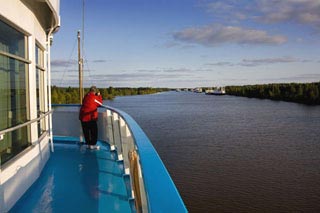
Copyright © Noella Ballenger
Enjoying the view from the bow of the cruise ship as we sailed along the Svir River.
In the last part of our adventures I told you about St. Petersburg, Russia and the many, many beautiful palaces and museums that housed stunning works of art. Art is a passion for me and I was “blown away” by the beauty of the city and of the art that is housed there. And actually, being able to see and study these fabulous works of art was so special that I didn’t think any other part of Russia could come even close to thrilling me in that same way.
Wow, was I in for a few surprises! So join us again as we continue our journey on the waterways that connect St. Petersburg and Moscow.
One of the joys of a cruise adventure is being able to relax and enjoy the scenery. After the busy time that we had during our stay in St. Petersburg, we were more than happy to relax and watch, but my frustration as a photographer was that I couldn’t get out and explore as we slowly passed something interesting. Compromise obviously was the name of this game!
We left St. Petersburg after dark and began our cruise along the Neva River. During our water excursion we would be traveling through approximately 27 locks–locks that are necessary when the ship is navigating dams which were placed across the rivers. During Stalin’s time in power, he wanted to link all of the Soviet Union with a waterway, so he built a series of canals and dams on the rivers and flooded many acres of prime farm lands–even towns and cities. As we cruised along the waterway, one could see the occasional flooded church tower protruding from the water. This deliberate flooding has been acknowledged as one of the worst ecological disasters in history.
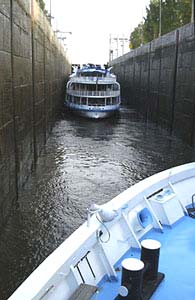
Copyright © Sunny Asch
Squeezing two large cruise ships into one lock takes careful manipulation.
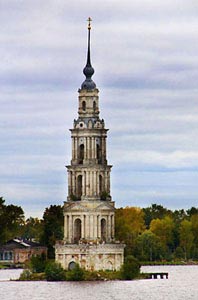
Copyright © Noella Ballenger
All that could be see of the village that once was here is the church steeple surrounded by water. It won’t be too many more years before nothing will be seen at all.
Going through the locks was a fascinating experience. The ship would come right up to the lock and then sail into a very narrow space (in some cases, only a few feet wider than the ship) and either rise or fall as the water was pumped in or out of the locks. We also discovered that there were several kinds of gates on the locks. Some gates were like barn doors, some like sliding doors and some that were a single piece that went up and down like an elevator. And on occasion, we felt a bit like sardines crammed in a can, as they would put two big ships really close together into the lock.
The general agenda for the trip was that each day we would cruise and then stop in an interesting location for about half a day, then return to the ship and continue our journey. This agenda helped make our trip really interesting.
The first of the small towns we visited was called Mandrogy–a small community of traditional Russian folk artists. They create beautiful carvings, bead work and other items that are typical of the folk art of the area. The community has only two rules by which they live–no one drinks alcohol and no one steals in the village.
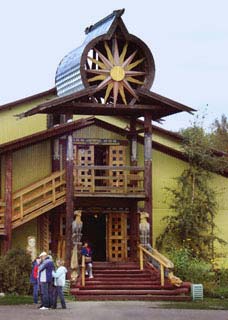
Copyright © Sunny Asch
Mandrogy featured a number of new and interesting architectural buildings as well as older cottages. This building housed shops featuring the local folk art of Russia.
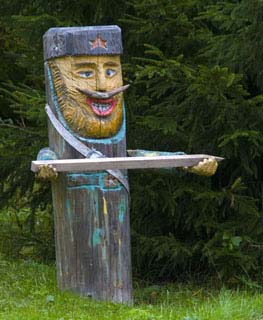
Copyright © Noella Ballenger
Carved posts in Mandrogy dotted the walkways pointing in the direction of shops and other town features.
The Arts and Crafts of the Regions Along the Russian Waterways
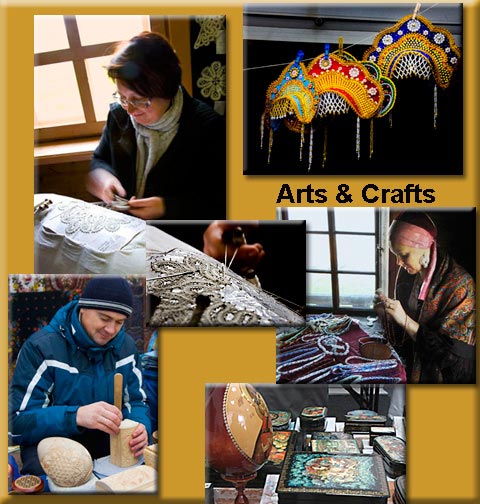
Upper Left: Lady working the art of tatting … making lace in Ulgich. Note how quickly she is moving her hands to make the intricate pattern. Copyright © Noella Ballenger
Center: Close-up of the fine lace work in progress. Copyright © Noella Ballenger
Upper Right: Traditional Russian headdresses featuring delicate and colorful bead work were for sale in the local shops of Mandrogy. Copyright © Noella Ballenger
Bottom Left: This gentleman did beautifully intricate geometric carving on birch boxes in Ulgich. Copyright © Noella Ballenger
Right center: A Russian artist stringing beads in Mandrogy. Copyright © Sunny Asch
Right bottom: One of the stores in Yaroslavl had a large selection of the lacquer boxes that are so famous in Russia. They are an outstanding example of Russian folk art with their delicately painted scenes depicting Russian fairy tales and historic and mythical moments. Copyright © Sunny Asch
A day later we had crossed Lake Onega, the second largest lake in Europe (actually the 18th largest by area in the world). Toward the northern end of that lake is Kizhi Island. This outdoor architectural museum is a small, intact and beautiful piece of old Russian history. The highlight of the island was seeing the beautiful wooden church–a fairy-tale structure built in 1714 without a single nail. As it has aged, the aspen shingles on the domes have taken on an enchanting silver sheen. In the early morning light it was breathtaking. And from there we entered into a home that was refurbished, showing us how the people in earlier times lived. Considering the freezing cold winters they have here, one had to admire the hardiness and strength of these early people.
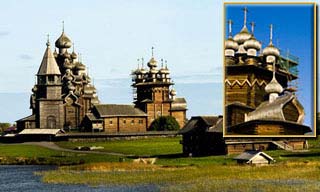
Large photo: Copyright © Stan Westfall
Smaller close-up: Copyright © Noella Ballenger
View of the church at Kizhi Island and the silver glow on the aspen shingles of the domes in the early morning light. The church featured many domes. The entire church was built without a single nail and is one of the most beautiful Russian churches of all that we saw.
The domes are meant to resemble candles and their flames.
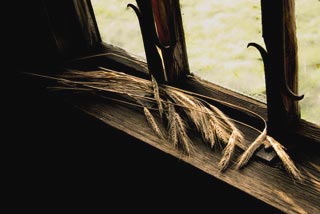
Copyright © Anne Westfall
Wheat in a window tells the story of Kizhi Island’s early residents.
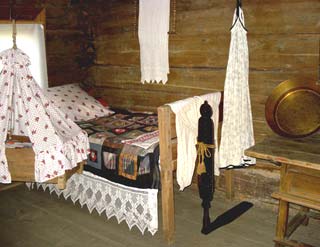
Copyright © Sunny Asch
This is a replica of the living quarters used by the people who lived in the town. It was bitter cold during the winter. Notice the covered baby cradle hanging from the rafters.
We returned to our ship and sailed back across the Lake Onega and continued our journey on the Volga-Baltic Waterway. As we cruised along these northern waterways we saw many industrial freight ships on the water, as well as large loads of timber on the shores, waiting to be loaded–the thick forests lining the rivers contribute to an active (substantial) timber trade.
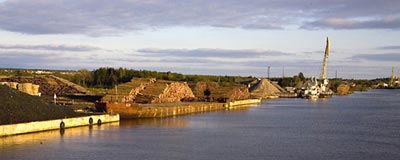
Copyright © Noella Ballenger
Storage areas for timber and other commodities wait to be transported on the rivers.
The next day we stopped on the shores of Lake Siverskoye, near the small city of Goritzy, which is home to a beautiful old monastery called the Kirillov–Belozersky Monastery. The monastery was founded in 1397 andin the 16th century, it was the second richest landowner in Russia–the Trinity Monastery near Moscow came first.The murals, which are still visible, date from 1641. The vast walled area of the monastery is nearly ½ mile long and 2 feet thick and was constructed in 1654-80. The monks were readmitted into the higher priory in 1998. The monastery is in the process of being restored and refurbished, so I’m glad we could still see it partly in its old condition. There was a small museum on the grounds that housed many pieces of art work as well as armaments, clothing and religious pieces such as icon covers. Our visit to the monastery at Goritzy was far too short, but the boat was leaving and we had to hurry to get back on board.
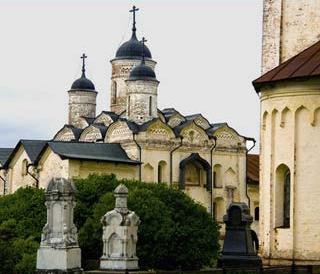
Copyright © Noella Ballenger
One of the several churches in the monastery. Several grave markers are in the foreground.
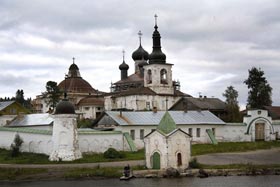
Copyright © Sunny Asch
The Kirillov–Belozersky Monastery has thick walls surrounding it. They served as protection during the earlier years.
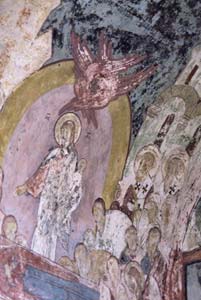
Copyright © Stan & Anne Westfall
Murals on a wall at the
Kirillov–Belozersky Monastery date from 1641.
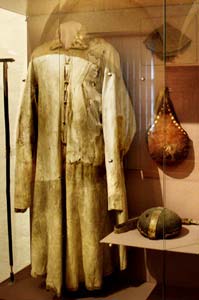
Copyright © Stan & Anne Westfall
In the museum at the Monastery they show the garments worn by the residents.
As we continued down the connecting waterways, we noticed that there were small communities near the shore lines that had small “houses” right along the river banks. These were actually boat storage facilities. The people here use the waterways for transportation, fishing and pleasure. The dams generate electricity and many kinds of goods are moved along from city to city. During the winter months, much, if not all of this activity is stopped due to the weather and the water freezing. All boats are taken from the water and dry docked for the season. But when the rivers open again, they return to being the busy and productive waterways that we saw.
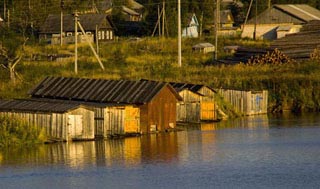
Copyright © Noella Ballenger
Small boat storage houses line the river near the villages. These waterways freeze during the winter months and boats need to be protected.
We stopped in Yaroslavl for some time and had a chance to wander around the city center. This town was founded in the early 11th century and, according to legend, on the very spot where Prince Yaroslav bravely killed a bear. This was a much livelier place and certainly more modern than some of the other towns we had visited. There was a lot of traffic and the people and homes just had a city feel to them. We visited a beautiful church as well as an open air market and a lovely shop where artists sold many of the small lacquered boxes that are famous throughout the world. These boxes are delicately painted with scenes from Russian fairy tales, historic or symbolic designs or places. They are wonderful treasures.
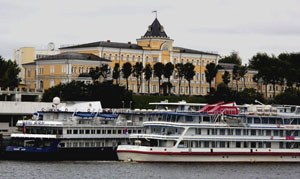
Copyright © Noella Ballenger
Tour boats dock near the a beautiful building in Yaroslavl. Yaroslavl was founded in the early 11th century. Today it is a modern city with theaters and many cultural opportunities.
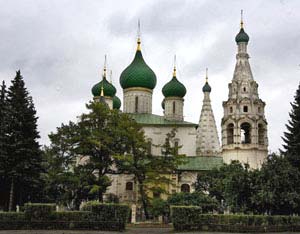
Copyright © Noella Ballenger
The Yaroslavl Church in Ilyinskaya Square–it is noted for its stunningly beautiful icons.
At Uglich, our last river stop before reaching Moscow, we had the chance to really walk through a small portion of the of this delightful city. There were some nice small shops, along with some historic buildings and gardens. And, Uglich is said to be one of the best shopping spots along the river, with its long outdoor section of booths. There were many interesting things for sale and some of the artists were there as well. Nearby was the Bankomat–the Russian ATM machine. My sister and our friend tried to use it, but of course, everything was in Russian. A lovely lady from the nearby hotel came to the rescue, so they did manage to get the machine to cooperate. It was an interesting experience!
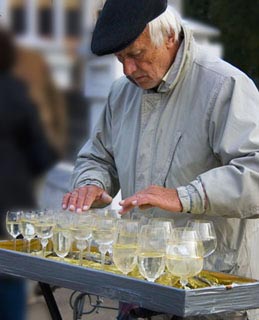
Copyright © Noella Ballenger
We were entertained in Uglich by this man playing music on glasses filled with various levels of water. Each one made a distinct note and the melody was lovely.
In Uglich it was possible to purchase furs, including fur hats in the street markets and open air shops in many places along the way.
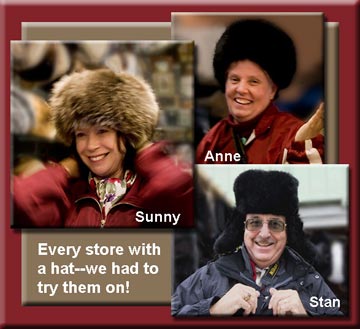
The closer we got to Moscow, the more industrial and the more prosperous the country and the people seemed to become. We passed some beautiful homes and saw quite a few new homes under construction. There were a number of churches that seemed to be actively in the process of restoration. We even passed a building and dock that was said to be a yacht club. It just wasn’t what we expected to see along the Russian waterways.
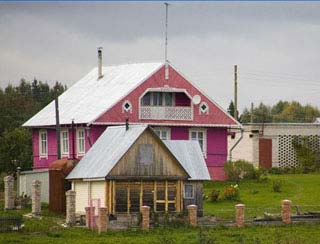
Copyright © Noella Ballenger
Colorful homes and small villages could be seen as we cruised the rivers.
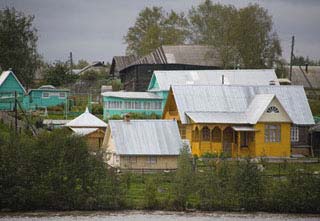
Copyright © Noella Ballenger
It always brightened our day to see a great splash of color along the river banks.
Far sooner than we wanted, we began passing many apartment buildings and other large buildings and were docked in Moscow.
In the next and last segment of this travel article on Russia, I’m going to share some of the interesting places we visited and some of the fascinating sights we saw in Moscow. Also I’ll share with you some of my thoughts and impressions on Russia, along with some additional photo tips.
READ MORE OF THE STORY AND SEE MORE PHOTOS…………
Be sure to join us next month as we visit Moscow.
Read Travel Adventures – Part 1: Finland and Estonia
Read Travel Adventures – Part 2: St. Petersburg, Russia
Read Travel Adventures – Part 4: Moscow
by Noella Ballenger

Leave a Reply